Deep Focus: Annihilation
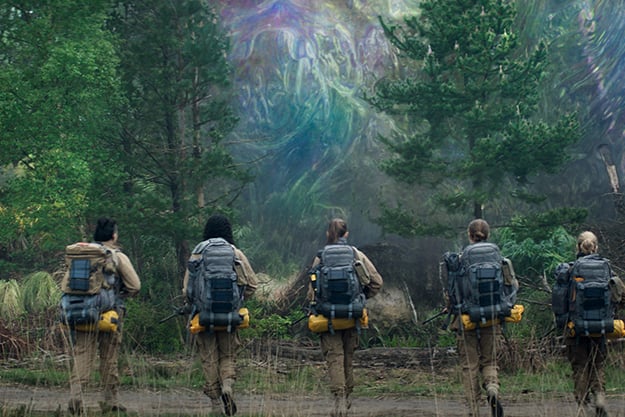
“When you see beauty in desolation it changes something inside you,” writes the first-person narrator of Jeff VanderMeer’s 2014 novel, Annihilation. “Desolation tries to colonize you.” Rather than reciting those words back to us, Alex Garland, the writer-director of the splendidly free movie adaptation, makes us experience their meaning in our bones. In this alternately hypnotic and pulse-quickening combination of harrowing survival tale and high-flown ecological parable, an all-female reconnaissance unit enters a southern zone of the North American coast where nature has gone haywire. Mutated beasts roam the rainforest and marshlands, plants sprout into gorgeous and disturbing shapes all the way to the beach, while something in the air scrambles the team’s communications and GPS signals. And this environmental flux keeps expanding its boundaries. What’s ultimately at stake is the fate of the Earth.
The simultaneously upsetting and mesmerizing atmosphere proves a seductive mix for the audience and a dangerous one for Johns Hopkins biology professor Lena (Natalie Portman), an Army veteran and the wife of an elite serviceman named Kane (Oscar Isaac)—the only member of previous squads to make it out alive. Kane inexplicably reappears after a year as a shadow of his former self, and almost immediately experiences multiple organ failure. So Lena, looking for the cause or a cure, volunteers for the latest mission. Dr. Ventress (Jennifer Jason Leigh), a psychologist, accepts her into the group, which includes paramedic Anya Thorensen (Gina Rodriguez), anthropologist Cass Sheppard (Tuva Novotny), and physicist Josie Redek (Tessa Thompson).
Here as in Ex Machina (2015), Garland’s creative élan comes from his merging of sleek conceptual art and messy, juicy drama. From the opening moments, when a man in a white hazmat outfit interrogates Lena in a blank, sterile room, Garland fractures time and space as boldly as the unknown force in the wilderness mixes and matches DNA. Lena says she’s sure that two comrades are dead; she’s unsure about what happened to the other two. In the ominous sci-fi blankness of the “Area X” interrogation quarters, Lena’s fraught uncertainty generates fascination as well as suspense.
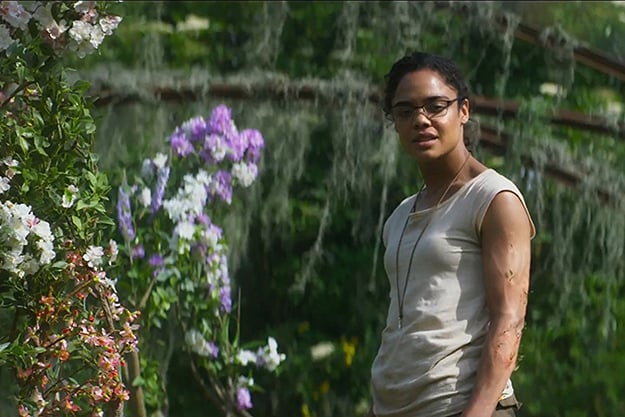
Even before the flashbacks proper, Garland cuts to shots of a fiery beam from nowhere zapping a lighthouse on the shore, an image of cell division that recalls the Hubble telescope’s pictures of new heavenly bodies, and a clammy close-up of reptilian tissue. Garland is proclaiming his story’s cosmic reach from the outset. But instead of drifting into pretentious ambiguity, he pulls us into Lena’s personal and professional drama, which in turn illuminates his themes. She specializes in mitosis—how a cell multiplies by splitting itself up. The whole movie is about the conflict between creative and impulsive self-destruction.
Every inch of the drama depicts units coming together and apart, including Lena and Kane’s marriage and her and Ventress’s expeditionary group. In flashbacks within the primary flashback, it’s delightful to see that Isaac’s Kane once had genuine erotic-comic chemistry with Portman’s biologist. Garland displays his gifts for modern sexual banter when Lena mocks Kane’s idea that she’ll be “pining” for him like Monty Python’s deceased parrot did for the fjords. It’s also a triumph of performance: Portman and Isaac have rarely felt like fuller human beings. Garland’s choice of music for Lena’s home scenes is ideal: Crosby, Stills & Nash’s “Helplessly Hoping,” with its spot-on lyrics like “They are one person / They are two alone / They are three together / They are four for each other.”
We eventually learn that Kane’s prolonged, distant missions and need to preserve military secrecy, strained their bond; regret and guilt for an affair, as well as grief, now drive Lena to go where no women have gone before. And though Anya, Cass, and Josie appear even-keeled and collegial when they welcome her into the group, each nurses her own private wound: substance abuse (Anya), the loss of a child (Cass), and a propensity for cutting (Josie). Lena, afraid of their reaction, hasn’t confessed that her husband is the one soldier who preceded them and managed to come back. Ventress does know, but with her odd, distant, melancholy manner, she can’t unify them in a crisis. They’re a worrisome team played by a first-rate ensemble: the poignantly hesitant and inward-looking Thompson matches the power of the valorous, clear-eyed Novotny, and the turbulent, agonized Rodriguez. Leigh’s eccentric, sometimes whispering delivery, filled with enigmatic blends of bitterness and sadness, breathes life into the familiar figure of a manipulative, know-it-all psychologist.
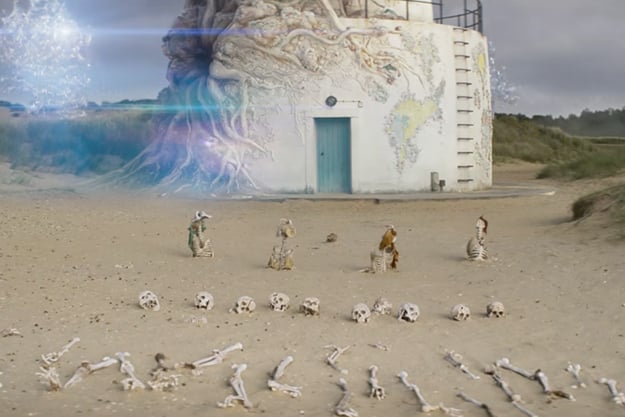
In the book, the whole catastrophe zone is called Area X; in the movie, Garland reserves that term for the emergency-response headquarters. He calls the affected landscape “The Shimmer.” Evoking a trembling, tenuous glow with echoes of the twilight word “the gloaming,” the Shimmer is the perfect name. A wall of patterned light surrounds the inland border, resembling a paisley design streaked with lines of white mercury. Beyond that scrim lies a jungle drenched in colors equally rich and hazy, as if we’re seeing a tropical patch through a perpetual, invisible drizzle. (Production designer Mark Digby, visual effects supervisor Andrew Whitehurst, and cinematographer Rob Hardy, conjure and sustain this audacious aura. )
Garland sweeps us up in this black magic while planting GMO seeds that will emerge with wonder and terror at the climax. Early on, Lena inspects a dazzling array of crazily different flowers that somehow belong to the same plant: they erupt in wild recurring patterns as if a madcap God had designed loony bouquets. When she examines the corpse of an enormous albino alligator, she notes that its teeth go in concentric rows, not like an alligator’s, but like a shark’s. In this vision of a world gone awry, a human corpse melds and explodes into masses of moss and brightly colored lichens. Eerier still, trees and shrubs carved by some topiary master take the forms of men, women, and children. What really shapes them, Josie theorizes, are human Hox genes—the ones that dictate the body plan of a species.
For most of the film, Garland roots the most outlandish strokes in flesh-and-blood adventure. The women face down that rampaging alligator, then paddle to safer ground amid towering swamp trees, like the National Guardsman in Walter Hill’s moody, compelling Southern Comfort. Lena and Ventress strive to maintain their goal of reaching the Lighthouse—the epicenter of this havoc—even after the group discovers hair-raising evidence from Kane’s doomed expedition that the ecological mayhem defies their powers of analysis.
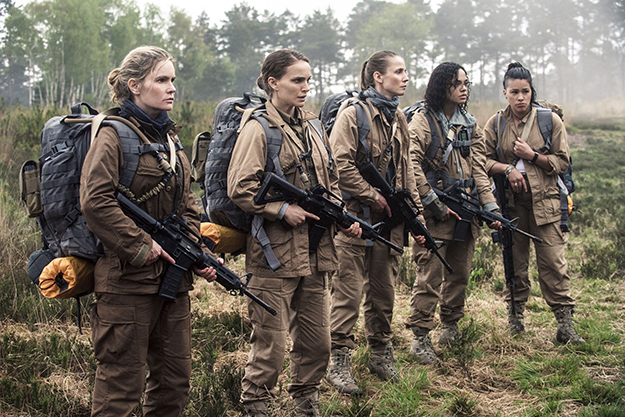
Contrary to advance reports of this film’s “difficulty,” Garland orchestrates conversations to confirm that we’ve seen what we think we’ve just seen, like a coiled thing taking over a man’s insides. Garland is not just a writer turned writer-director. He’s a novelist turned filmmaker, like James Clavell (who wrote 1958’s The Fly), and he has a born storyteller’s knack for keeping the action lucid while turning the screw. Just when we think the tension in a Grand Guignol scene couldn’t be more excruciating, Garland pays homage to Clavell’s depiction of the Fly squealing, “Help me!”
In the explosive, extended climax, Garland dares to be great. Inside the Lighthouse, Lena finds a confounding video account of Kane’s apparent self-immolation and the emergence of an unscathed doppelgänger facing him. And that’s only the first of multiple surprise metamorphoses. After Lena climbs down a black hole lined with the same fleshy, pulsing material we glimpsed near the beginning, she witnesses one of her comrades surrendering to the Shimmer, now embodied in a single, shape-changing creature. As she goes out in blazes, Lena raptly peers into this mini-inferno. The scene recalls a cryptic prediction in the book: “There shall be a fire that knows your name, and in the presence of the strangling fruit, its dark flame shall acquire every part of you.”
At a key point in the dialogue, Josie realizes that the Shimmer “refracts” everything in its path, from light and sound waves to genetic coding. What Garland does throughout the movie is refract the book. He comes up with fresh, wholly original scenes that bring home VanderMeer’s themes in visceral and visually memorable ways. At Garland’s apex of invention, the Shimmer takes on a grey humanoid form and does an imitative pas de deux with Lena—a freakishly effective demonstration of a non-human mirroring a person’s every move. It’s a terrifyingly lyrical expression of Lena’s summary statement in the book: “It creates out of our ecosystem a new world, whose processes and aims are utterly alien—one that works through supreme acts of mirroring, and by remaining hidden in so many other ways, all without surrendering the foundations of its otherness as it becomes what it encounters.”
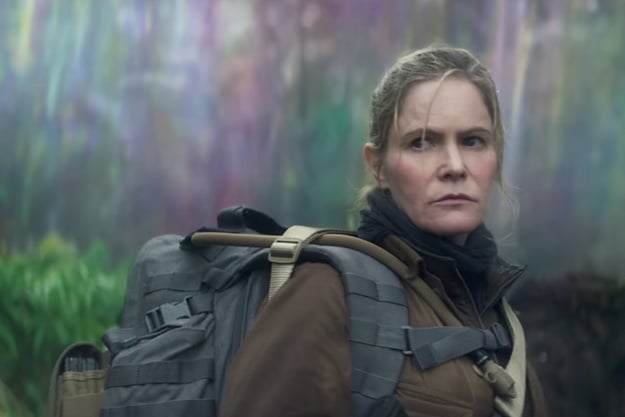
Several creative shortfalls throw us out of the movie for minutes at a time. The women bravely breach the Shimmer, then wake up groggy and disoriented three or four days later. Without any development or explanation, their blackout is a flimsy, daydreamy touch: it’s jarring to hear Ventress order them to pack up and get moving. (This whole scene plays like an undigested gimmick from the book.) Occasionally, Garland misjudges a shot: I couldn’t see exactly what drives Lena to discover whether a colleague presumed dead is still alive. Garland triumphs at peak moments, but should work on his transitions. The film’s flashes of sophisticated humor make us wish for more.
No director of his generation (he’s 47) has measured himself so thrillingly against the Tarkovsky of Stalker and the Kubrick of 2001: A Space Odyssey and remained his own man. His ambiguity is playful and insightful, not just a smokescreen for foggy ideas and visual notions. At the end of 2001, Kubrick portrays man’s evolution into Star Child as a noble death and transfiguration. With his movie’s echoes of Fukushima and Chernobyl, Garland makes us ponder how we risk losing our humanity when we trespass against nature. When we do, our fate will be to fall, as Lena says in the book, into “some prolonged form of annihilation.”
Michael Sragow is a contributing editor to Film Comment and writes its Deep Focus column. He is a member of the National Society of Film Critics and the Los Angeles Film Critics Association, and a programmer at the Criterion Collection.







